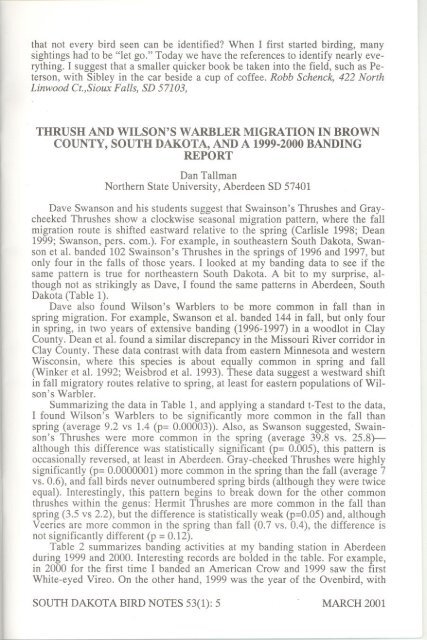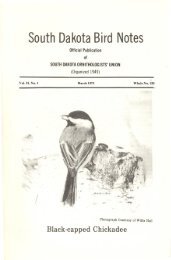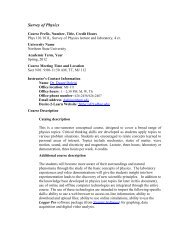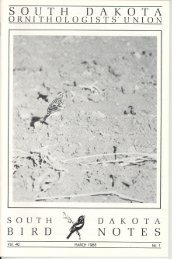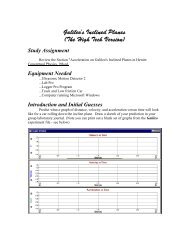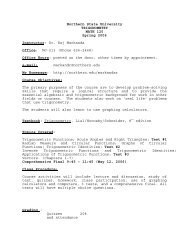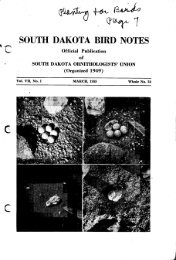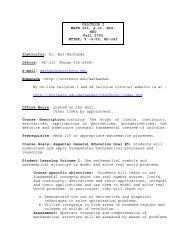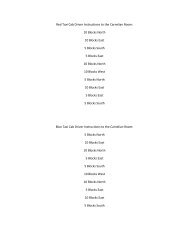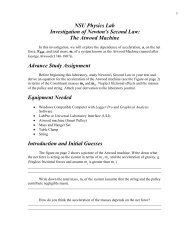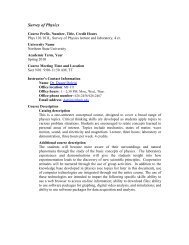fication of Birds of North America written by Robbins, et aI., and published byGolden, was in one pocket. Its current condition is much the same as my PetersonGuide. Peterson's weakest point was range descriptions, for example, EasternKingbird "Range:-Breeds in rural country from Nova Scotia, s. Quebec,and Manitoba s. to Gulf of Mexico." For me this brevity leaves a lot of countryin question. The Golden guide added range maps and had the text and map besidethe plate. At a glance, one could determine if a species occurred in the area.Golden also added lines to the range maps, indicating how far north migratingbirds would be for each month of the spring, a good idea that has not been repeatedsince. The range maps were great, but it was necessary to limit the text tothe space available. "All" the birds of North America where covered by Golden,a very big plus to South Dakota birders, who must deal with both eastern andwestern birds. The biggest disadvantage to the Golden guide was the lack of aquick reference to the identifying field marks of a species. Peterson's guideshave arrows pointing to the field marks that identify a bird. This method ofidentifying birds is wonderful training. Field marks are the only way to identifybirds with assurance and are absolutely necessary in a rare bird report.In 1980, a fourth edition of Peterson's guide was released. This guide followedthe format of text and plate side by side. Large range maps were includedin the back of the book, making their use clumsy at best. The plates are some ofthe best ever drawn, but this format, unfortunately, limited the text to the spaceavailable. Still, the quality of the plates made this guide the best on the market.When I joined SDOU, I was introduced to National Geographic Society'sField Guide to the Birds of North America; it became my field guide of choice.The cover is wrinkled and its pages are spotted with coffee stains, the result ofits spending most of its time on the seat of my car. National Geographic's guideis larger, nearly twice the size of previous guides. Either due to its size or my notneeding field guide as often, I found that it was not going into the field as muchas my other guides. This guide included the best plates and more plumages thanany other book to date, with range maps similar to the Golden book. NationalGeographic's text is not as gripping as Peterson's, but it did cover field marks.During National Geographic's tenure, many other books dedicated to families ofbirds were written. These references are great and include more plumages thanever before. A single field guide was no longer enough. When going to birdwarblers, the warbler book went along, when birding gulls, a book on gulls wasin the car, etc.Today we have the National Audubon Society's The Sibley Guide to Birds.This guide is more comprehensive than its predecessors. As an example, Peterson'sguide had five illustrations of Red-tailed Hawks. The Sibley guide has 41illustration of that species, showing all recognizable subspecies. The quality ofSibley's plates is hard to beat. Sibley's text, in general, is very limited. Somequestion whether Sibley's guide is actually a "field" guide. Few pockets arelarge enough to accommodate this book. As a single reference to help with thattroubling bird that does not fit the descriptions in other guides, Sibley's bookcannot be beat.Would I go back to the field guides I started with? No, but I do miss the narrativethat described birds like no picture can. For the beginner I believe Peterson'snewest edition is still the best guide. It teaches identification through fieldmarks and does not overwhelm the way Sibley may. A birder may not be able toidentify all birds with this guide, but isn't that one of the first lessons of birding,lSOUTH DAKOTA BIRD NOTES <strong>53</strong>(1): 4 MARCH <strong>2001</strong>
that not every bird seen can be identified? When I first started birding, manysightings had to be "let go." Today we have the references to identify nearly everything.I suggest that a smaller quicker book be taken into the field, such as Peterson,with Sibley in the car beside a cup of coffee. Robb Schenck, 422 NorthLinwood Ct.,Sioux Falls, SD 57103,THRUSH AND WILSON'S WARBLER MIGRATION IN BROWNCOUNTY, SOUTH DAKOTA, AND A 1999-2000 BANDINGREPORTDan Tallman<strong>Northern</strong> <strong>State</strong> <strong>University</strong>, Aberdeen SD 57401Dave Swanson and his students suggest that Swainson's Thrushes and GraycheekedThrushes show a clockwise seasonal migration pattern, where the fallmigration route is shifted eastward relative to the spring (Carlisle 1998; Dean1999; Swanson, pers. com.). For example, in southeastern South Dakota, Swansonet al. banded 102 Swainson's Thrushes in the springs of 1996 and 1997, butonly four in the falls of those years. I looked at my banding data to see if thesame pattern is true for northeastern South Dakota. A bit to my surprise, althoughnot as strikingly as Dave, I found the same patterns in Aberdeen, SouthDakota (Table 1).Dave also found Wilson's Warblers to be more common in fall than inspring migration. For example, Swanson et al. banded 144 in fall, but only fourin spring, in two years of extensive banding (1996-1997) in a woodlot in ClayCounty. Dean et al. found a similar discrepancy in the Missouri River corridor inClay County. These data contrast with data from eastern Minnesota and westernWisconsin, where this species is about equally common in spring and fall(Winker et al. 1992; Weisbrod et al. 1993). These data suggest a westward shiftin fall migratory routes relative to spring, at least for eastern populations of Wilson'sWarbler.Summarizing the data in Table 1, and applying a standard t-Test to the data,I found Wilson's Warblers to be significantly more common in the fall thanspring (average 9.2 vs 1.4 (p= 0.00003)). Also, as Swanson suggested, Swainson'sThrushes were more common in the spring (average 39.8 vs. 25.8)-although this difference was statistically significant (p= 0.005), this pattern isoccasionally reversed, at least in Aberdeen. Gray-cheeked Thrushes were highlysignificantly (p= 0.0000001) more common in the spring than the fall (average 7vs. 0.6), and fall birds never outnumbered spring birds (although they were twiceequal). Interestingly, this pattern begins to break down for the other commonthrushes within the genus: Hermit Thrushes are more common in the fall thanspring (3.5 vs 2.2), but the difference is statistically weak (p=0.05) and, althoughVeeries are more common in the spring than fall (0.7 vs. 0.4), the difference isnot significantly different (p =0.12).Table 2 summarizes banding activities at my banding station in Aberdeenduring 1999 and 2000. Interesting records are bolded in the table. For example,in 2000 for the first time I bandedan AmericanCrow and 1999saw the firstWhite-eyed Vireo. On the other hand, 1999 was the year of the Ovenbird, withSOUTH DAKOTA BIRD NOTES <strong>53</strong>(1): 5 MARCH <strong>2001</strong>
- Page 1: I .SOUTH DAKOTA IORNITHOLOGISTS'UNI
- Page 6 and 7: - - ~1180 individuals banded and 20
- Page 8 and 9: L--: --..Dean, K. L. 1999. Stopover
- Page 10 and 11: I was listening to an unusual sparr
- Page 12 and 13: ..of Black-backed Woodpeckers incre
- Page 14 and 15: .~24 Sep Meade JLB ... Late [l5-Nov
- Page 16 and 17: ..-- --- --Yankton SVS; 02 Aug Robe
- Page 18 and 19: ..American Tree Sparrow Early: 03 O
- Page 20 and 21: PubUshed bySOUl1l DAKOTAORNI1HOLOGI
- Page 22 and 23: SOUTH DAKOTA BIRD NOTES, the offici
- Page 24 and 25: ..ess that is being fought against.
- Page 26 and 27: White-fronted Goose 13% 6Snow Goose
- Page 28 and 29: Hairy Woodpecker 91% 41Black-backed
- Page 31 and 32: - - -Grzybowski, 1. A. 1999. Southe
- Page 33 and 34: en0ẹ..,::r:t:J~0~OJ....:;.:;t:JZ0
- Page 35 and 36: ~A GUIDE TO THE BIRDS OF THE PHILIP
- Page 37 and 38: Brookings KIE; 11 Feb Hughes RDORed
- Page 39 and 40: TJ; 20 Jan Hughes JSP, RFSPurple Fi
- Page 41 and 42: ~!I: ORNITHOLOGISTS'I SOUTH DAKOTAU
- Page 43 and 44: ..~PRESIDENT'S PAGEI had such a bla
- Page 45 and 46: -erably prior to consulting a field
- Page 47 and 48: SUBMITTEDFOR CONSIDERATIONEurasian
- Page 49 and 50: '"young cormorants, near flight sta
- Page 51 and 52: - --"only one genus of the family S
- Page 53 and 54: ~SEASONAL REPORTSThe 2001 Spring Se
- Page 55 and 56:
----KM; 08 Apr Butte JLBCinnamon Te
- Page 57 and 58:
,-----0Apr Minnehaha RBA; 17 May Be
- Page 59 and 60:
Pileated Woodpecker Only Report: 15
- Page 61 and 62:
07 MayUnion RBA ...Late: 12 May McC
- Page 63 and 64:
,I~haha RFS, JSP; 11 May Meade EEMB
- Page 65 and 66:
Contributing ObserversRBADBJLBKBAPB
- Page 67 and 68:
.~lSD State Lists (31 December 2000
- Page 69 and 70:
- ---- JSOU T H D A K 0 r~ORNITHOLO
- Page 71 and 72:
...~PRESIDENT'S PAGEThe September m
- Page 73 and 74:
emained at the refuge for 11 days b
- Page 75 and 76:
_INelson has cut back sunflower pla
- Page 77 and 78:
problems." He explained that Wildli
- Page 79 and 80:
within two hours.) Some non-target
- Page 81 and 82:
'\of USFWS, Mountain-Prairie Region
- Page 83 and 84:
takes three days for the bird to di
- Page 85 and 86:
- ,..,rcording to Gamble.NORTH DAKO
- Page 87 and 88:
~IrSMALL RESEARCH GRANTS AVAILABLE
- Page 89 and 90:
';IWhite-faced Ibis reported from H
- Page 91 and 92:
Whip-poor-will Reported from Lincol
- Page 93 and 94:
Meade, Pennington and Stanley co.Ea
- Page 95 and 96:
REPRFSSSNSSVSDRSDSRandy E. PodollRo


